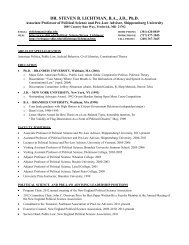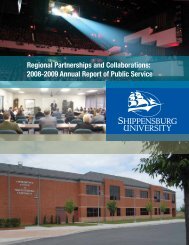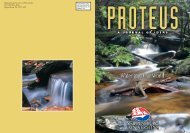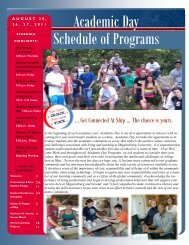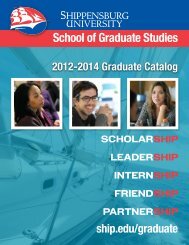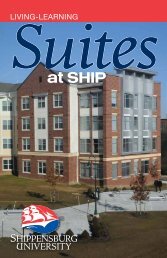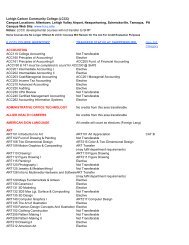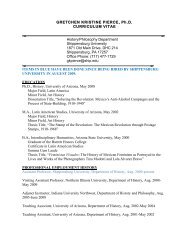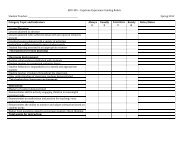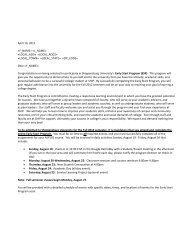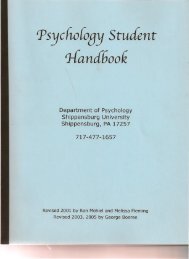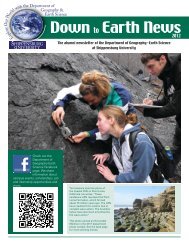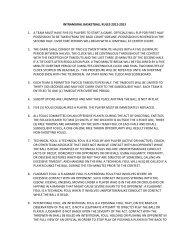2007-2008 Annual Report of Service - Shippensburg University
2007-2008 Annual Report of Service - Shippensburg University
2007-2008 Annual Report of Service - Shippensburg University
You also want an ePaper? Increase the reach of your titles
YUMPU automatically turns print PDFs into web optimized ePapers that Google loves.
10 <strong>Shippensburg</strong> <strong>University</strong><br />
<strong>Shippensburg</strong> <strong>University</strong><br />
Fashion Archives and Museum<br />
Dr. Karin J. Bohleke, Director<br />
Kevin Bowman, Graduate Administrative<br />
Assistant<br />
Gina Chippie, Kathleen Johnston and Sarah<br />
Pereira, Work-Study Students<br />
The SU Fashion Archives and Museum<br />
(SUFAM) is a unique educational laboratory<br />
and museum that enhances our understanding<br />
<strong>of</strong> society through the study <strong>of</strong> dress. Since<br />
its establishment in 1980, the Archives have<br />
served as a teaching, research and exhibition resource<br />
both for university students and faculty<br />
and for members <strong>of</strong> the greater South Central<br />
Pennsylvania community and nearby states.<br />
It operates in association with <strong>Shippensburg</strong><br />
<strong>University</strong>’s College <strong>of</strong> Arts and Sciences and<br />
the Institute for Public <strong>Service</strong>. The primary<br />
function <strong>of</strong> the Archives is to preserve and<br />
exhibit its collection <strong>of</strong> clothing and accessories<br />
and to make those materials available for<br />
teaching and research purposes to persons and<br />
groups both on- and <strong>of</strong>f-campus.<br />
Collections<br />
The Archives’ 14,000-item collection<br />
<strong>of</strong> mostly donated items consists <strong>of</strong> clothing<br />
and accessories worn by men, women and<br />
children, dating from the late eighteenth to<br />
the twentieth centuries. Primarily focused on<br />
middle- and working-class Americans, clothing<br />
from all walks <strong>of</strong> life is represented in the<br />
collection. Visitors to the Archives can see<br />
beaded Charleston dresses from the 1920’s,<br />
a Depression-era “hobo”outfit and Chinese<br />
binding shoes. The Archives takes pride in its<br />
pieces from designers such as Chanel, Scaasi,<br />
Cashin and Trigere. Special collections are<br />
housed within the Archives:<br />
1. The Pennsylvania Collection<br />
This collection contains examples <strong>of</strong><br />
clothing manufactured in Pennsylvania<br />
and related to the history <strong>of</strong> its garment<br />
industry.<br />
2. The <strong>Shippensburg</strong> <strong>University</strong> Collection<br />
Featured in this collection are pieces<br />
related to the people and history <strong>of</strong> the<br />
university, including alumni and faculty.<br />
3. The Try-On Collection<br />
A hands-on approach is taken with this<br />
collection. Here students can utilize<br />
duplicate or non-archival garments to<br />
understand construction, textiles and the<br />
social and cultural relevance <strong>of</strong> clothing.<br />
4. The Reference Collection<br />
The Fashion Archives houses an extensive<br />
reference library <strong>of</strong> fashion-related<br />
publications consisting <strong>of</strong> hundreds <strong>of</strong><br />
volumes. The holdings are accessible<br />
via Lehman Library’s on-line catalog<br />
database. Researchers may consult the<br />
books during regular operating hours. As<br />
it is a special collection, the materials are<br />
non-circulating.<br />
5. The Ephemera Collection,<br />
The Fashion Archives has large holdings<br />
<strong>of</strong> original catalogs, fashion magazines,<br />
fashion plates and related ephemera dating<br />
back to the 1840s for those wishing<br />
to research costume-related topics in<br />
original source material.<br />
Current Collection Policy<br />
Space limitations have compelled the<br />
Archives to freeze large-scale acquisitions on<br />
a temporary basis, but potential donors are encouraged<br />
to contact the facility as particularly<br />
select items can still be housed. Due to conservation<br />
issues, the Archives cannot accept any<br />
natural furs.<br />
Facilities<br />
The Archives is located on the lower level<br />
<strong>of</strong> Harley Hall, a campus residence hall. The<br />
facility includes an exhibition gallery, a collection<br />
storage area, a classroom area, and a combination<br />
workroom and <strong>of</strong>fice area.<br />
Organization<br />
A Board <strong>of</strong> Directors helps define the<br />
Archives’ goals and guide its operations, in<br />
cooperation with the College <strong>of</strong> Arts and<br />
Sciences and the part-time director, who<br />
administers the operation. One graduate assistant<br />
supports the director and three workstudy<br />
students assist in a variety <strong>of</strong> tasks,<br />
including exhibit preparation and object cataloguing.<br />
A corps <strong>of</strong> community and campus<br />
volunteers, some <strong>of</strong> whom help facilitate the<br />
on-going project <strong>of</strong> cataloguing, repairing and<br />
computerizing the Archives’ costume and library<br />
holdings, also provide essential support.<br />
The staff and volunteers also assist the Board<br />
<strong>of</strong> Directors in its current project <strong>of</strong> generating<br />
a substantial endowment fund, in cooperation<br />
with the <strong>University</strong> Foundation.<br />
Recent Activities<br />
The spring <strong>2008</strong> exhibit, “Garibaldis,<br />
Engageantes and Cages: American Fashions <strong>of</strong><br />
the Civil War Era,” was a record-breaking success<br />
that brought in visitors from New York to<br />
Florida and from the mid-West and the West.<br />
The Archives hosted hundreds <strong>of</strong> <strong>of</strong>f- and<br />
on-campus exhibit researchers visitors <strong>of</strong> all<br />
ages, and also hosted a visit from the Atlantic<br />
Region II chapter <strong>of</strong> the Costume Society <strong>of</strong><br />
America. The accompanying catalog went<br />
through three printings, and the possibility <strong>of</strong><br />
a fourth printing is still under consideration,<br />
This is one <strong>of</strong> the gallery shots taken at our<br />
grand exhibit opening on Feb. 7, <strong>2008</strong>.<br />
even though the exhibit is formally closed.<br />
Preparations are underway for the next<br />
exhibit, “Extreme <strong>of</strong> Black and White and<br />
Shades <strong>of</strong> Gray,” which opens on October 23,<br />
<strong>2008</strong> and will run through March 4, 2009. The<br />
exhibit explores the symbolism behind these<br />
colors in Western culture: black is associated<br />
with glamour, conservatism and mourning,<br />
whereas white is loaded with connotations <strong>of</strong><br />
virginity and purity, as well as considered cool<br />
and highly practical in the summer. Gray, the<br />
result <strong>of</strong> blending black and white, also has its<br />
symbolic burden in terms <strong>of</strong> conservatism and<br />
mourning. A full-color catalog will accompany<br />
this exhibit, which features clothing dating<br />
back to the 1820s. Other garment highlights<br />
include gowns from the 1850s, a full array <strong>of</strong><br />
nineteenth-century mourning clothing, accessories<br />
and hair jewelry, and exquisite evening<br />
and day wear from the nineteenth and twentieth<br />
centuries.<br />
Reaching out to the campus and outside<br />
communities, the Archives provided costume<br />
and accessory loans and pr<strong>of</strong>essional expertise.<br />
The Cumberland County Historical Society<br />
borrowed items for their 1930s exhibit. The<br />
Washington County Art Museum will be<br />
borrowing 1920s clothing for a forthcoming<br />
exhibit, slated to open in early 2009. In addition,<br />
current director Dr. Karin J. Bohleke<br />
has given lectures on Civil War clothing at<br />
the “March to Destiny” annual reenactment<br />
in <strong>Shippensburg</strong> and for a monthly meeting<br />
<strong>of</strong> the Adams County Historical Society. She<br />
taught a workshop on Civil War-era women’s<br />
patriotic aprons for the Ladies and Gentlemen<br />
<strong>of</strong> the 1860s conference held in Harrisburg<br />
in March. She will also be teaching a class<br />
on Victorian fine hand-sewing and finishing<br />
techniques for the Lehigh Valley Couturier<br />
Society in November <strong>2008</strong>.<br />
SUFAM has continued its pattern drafting<br />
program, and at this time has pr<strong>of</strong>essionally<br />
prepared patterns for a ca. 1790s-1800s



